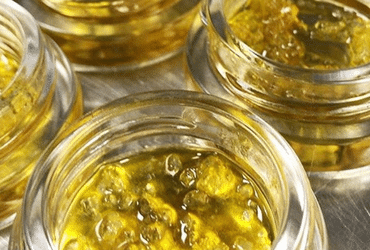If you’re looking for maximum flavor and potency from your cannabis, concentrates are a good choice. Offering a selection of the plant’s natural cannabinoids and terpenes in a concentrated form, cannabis concentrates can deliver a rich dose of THC, as well as offer benefits to health and wellness like fighting inflammation. In this article, we’ll walk you through the different types of cannabis concentrates, how they’re made and which one is right for you.
What Are Cannabis Concentrates?
Cannabis concentrates are powerful extractions of cannabinoids, terpenes and other chemical compounds from the cannabis plant, most notably tetrahydrocannabinol (THC) and cannabidiol (CBD).
If you look closely at the cannabis plant, you’ll see thousands of tiny translucent hairs called trichomes. This is where cannabinoids, including THC and CBD, are produced. With cannabis concentrates, the cannabinoids and terpenes are extracted from the trichomes, and the rest of the plant material is left behind. As a result, concentrates are far more potent by weight than other cannabis products.
Solventless vs. Solvent-Extracted Concentrates
There are two main techniques for extracting cannabis concentrates. Some producers use solvents (usually some sort of hydrocarbon), while others go for a solventless method involving water, heat or pressure. Traditionally, solvent-extracted concentrates have usually had a higher THC level (over 80%), whereas nonsolvent concentrates, while still more powerful than cannabis flower, have tended to feature lower per-gram levels of THC. That pattern is rapidly evaporating today, though, as new extraction techniques and technologies have increased the potency and purity of solventless extracts.
Solvent-extracted concentrates use a solvent, such as ethanol, CO2, butane or propane, to isolate the plant’s terpenes and cannabinoids into a consumable form. The different forms of these concentrates mostly vary from one another in terms of texture, but they also have important differences in their terpene and cannabinoid profiles.
Extracts vs. Concentrates — What’s the Difference?
While the two terms are often used interchangeably, “extracts” and “concentrates” have two slightly different meanings. Concentrates are all of the concentrated forms of cannabis, while extracts are specifically solvent-extracted concentrates. All extracts are concentrates, but not all concentrates are extracts. For example, concentrates like hash and rosin are not extracts, because they are not produced with a process of solvent-based extraction.
Live vs. Cured Resin
Cured resin is a concentrate made from cured, or dried, flower. This is the typical way to make extracts, and most concentrates on the market fall under the category of cured resin. Cured resin will carry the same aromas and flavor profiles as a jar of dried bud. Similar to an aged bottle of wine, the compounds in cured resin have been given time to mature. The terpene levels of cured resin are generally lower than those of live resin, because the plants’ terpene profile evolves as it dries.
Live resin, on the other hand, maintains the flavor and terpene profile of the living cannabis plant. Artisan concentrate-makers begin by flash-freezing the freshly harvested plant. It’s the same principle applied to frozen vegetables: by sealing it up before oxidation can begin, the full profile of nutrients (in the case of vegetables) or terpenes and cannabinoids (in the case of cannabis) are preserved. The cannabinoids are then extracted at low temperature, typically using solvent-based techniques, though the terms “live resin” and “cured resin” can technically refer to solventless concentrates as well. The result is a concentrate that includes a full spectrum of compounds to offer smokers the whole-flower experience—along with, potentially, a greater array of beneficial therapeutic outcomes delivered via the body’s endocannabinoid system.
Common Types of Concentrates
For someone who wants to consume cannabis concentrates, there are three main things to consider. First is the consistency, or the physical texture of the concentrate, which will affect how you consume it. Second is the extraction technique: is it live or cured? And third is the strain’s effect profile, which depends on its specific blend of terpenes and cannabinoids.
Shatter
Hard to the touch and amber in color, shatter is a form of solvent-extracted concentrate named for its translucent appearance and crumbly texture. The most common way to enjoy shatter is to vaporize or dab the product. The key difference between shatter and other, waxier kinds of concentrate is that the others are agitated during processing, whereas shatter is left still to assume its glass-like appearance.
Badder, Budder, Crumble, Sugar, Etc.
These wax-style concentrates are some of the most popular forms of solvent-extracted cannabis concentrate, offering high levels of THC and a huge range of options when it comes to texture and consistency. They’re generally thick and sticky (although some types are more crumbly or crystalline), so dabbing or vaping are the easiest ways to enjoy them.
Diamonds
Another flash-frozen extract, these concentrates look about how you’d expect from their name. The big surprise, however, is that this form of cannabis captures the plant’s THCa—the raw, unprocessed form of THC—offering a clear-headed high and a wide range of health benefits. They range in size from tiny to chunky, and can be consumed via dab rig, tabletop vaporizer or an e-rig.
Sauce
Terpene-rich cannabis concentrate sauce has a thick, sticky consistency and a warm, golden color. It’s a favorite among concentrate connoisseurs for its rich flavor profile thanks to its high concentrations of terpenes. Solvent-extracted from either cured or flash-frozen flower, sauce is often vaporized, dabbed, or used in cannabis vape pens.
Hash
Hash is the original solventless concentrate. Like most extracts, it’s made by removing and processing the trichomes of the cannabis plant. But hash-makers manipulate the flower physically rather than chemically, using pressure, sifting, and temperature to remove its resinous glands. The earliest form of hash may have been produced accidentally by farmers harvesting their hemp, but today, innovative new formulas like full-melt and bubble hash have led to a resurgence in the world of hash-making—both cutting-edge and traditional. New technologies have led to an explosion in the varieties of hash available now, from classic handmade formulas to cutting-edge, high-grade hash that can be vaporized, rather than smoked.
Rosin
A non-solvent extraction made using heat and a hydraulic press plus flower, hash or kief, rosin is a thick, viscous concentrate that retains most of the cannabinoids and terpenes of the original plant. You can find both live and cured rosin on the market, and it’s popular with users who want a solvent-free concentrate that offers strong flavor and abundant cannabinoids. Enjoy it with a dab rig, vaporizer or in vape pens for an aroma-rich hit.
FECO (Full Extract Cannabis Oil)/Rick Simpson Oil (RSO)
Named after the man with a cult following who developed it as a treatment for his own cancer, Rick Simpson Oil was originally made by soaking cannabis in isopropyl alcohol. Today’s versions use ethanol extraction or other solvents to produce a thick, oily tincture that is applied topically to the skin or taken sublingually. This kind of extract has very high levels of THC and other cannabinoids and is mostly used by medical cannabis users to manage their needs.
How To Consume Cannabis Concentrates
Because the consistency of cannabis concentrates varies so much, from silky budder to sugary crumble, there are numerous ways to enjoy it. These are the most common:
- Smoking: The simplest way to consume cannabis concentrates, and the most accessible for many cannabis users, is to smoke them alongside flower. Common methods of smoking concentrates include sprinkling hash, shatter or another concentrate onto your bowl or joint. Some people smoke hash using a special kind of pipe with a screen known as a chillum.
- Dabbing: Rather than burning cannabis as you would with combustible flower, dabbing heats the extract on a rapidly-heated metal or ceramic surface called a “nail.” This will bring the cannabis oils quickly up to their boiling point and release the cannabinoids in one go.
- Vaporizers: A simpler version of the dab rig, vaporizers heat the concentrate to just below combustion point with a battery-powered element rather than a naked flame or blow torch.
- Vape Pens: Portable, discreet, and pre-filled vape pens are becoming increasingly common. They work in the same way as the older style of flower-combusting vape pens, but use cannabis concentrate oil instead.
- Oral and Topical: Cannabis concentrates can be taken as an ingestible capsule or applied topically as a cream or gel. This is commonly the case for Rick Simpson Oil and is particularly common among medicinal, rather than recreational, users.
Which Concentrate Is Right for You?
If you’re new to cannabis concentrates, it’s easiest to start with a vape pen. These consist of an affordable battery and a removable, pre-filled oil cartridge. They come ready to enjoy, with a clear indication of the potency, and are discreet and portable.
Another common way to enjoy concentrates is dabbing, where you drop your product on a heated titanium, ceramic or quartz nail and inhale. This will vaporize your concentrate instantly, offering an immediate dose of cannabis perfect for regular users or those looking for instantaneous relief. Today, electronic dab rigs like the PuffCo Plus can take the guesswork out of dabbing and improve your experience by offering a clean, consistent hit every time.
For those who don’t want to fiddle around with rigs or accessories, and perhaps want to approach their concentrates the same way as they do their vitamin supplements or medications, edibles (e.g., capsules) or tinctures are perfect. These give you a clearly indicated dose per capsule or drop. Compared to the instantaneous impact of other consumption methods, edibles take longer to work (about 30 minutes, depending on the person).
The more you learn about cannabis concentrates and experiment with different forms, the more tempting it is to dig deeper into the source flower and explore the various strains offered at Solful and their curated effects.
Solful Cannabis Concentrates
You don’t have to choose between smoking flower and dabbing or vaping concentrates. In fact, many users will add some concentrate to their flower to boost potency. But if you’re looking for a powerful, aromatic, instant experience, cannabis concentrates deliver. Shop our full range of dab-ready hashes, rosins, budders, resins, and more.

